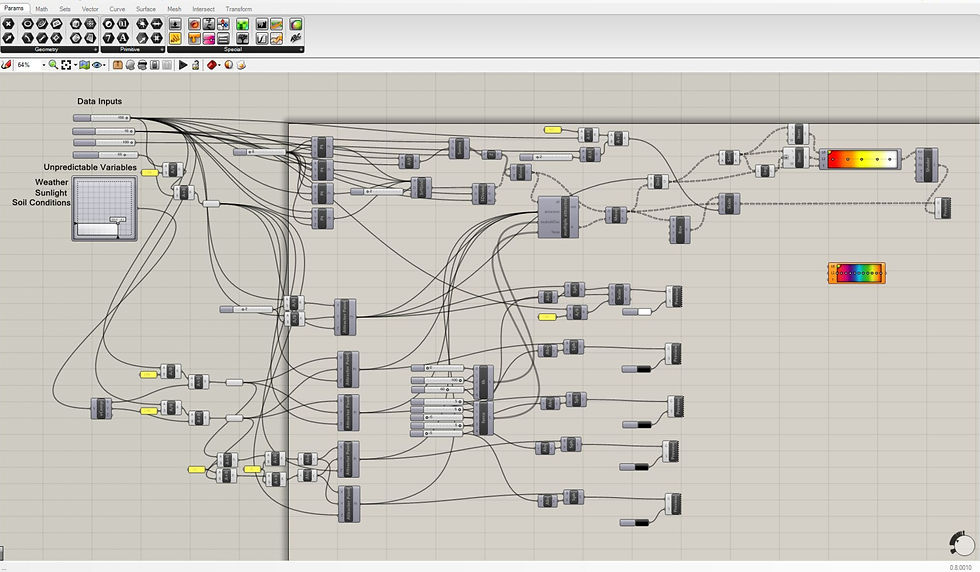Design is more than creating structures—it’s about storytelling. Through a process spanning two years of exploration and refinement, I’ve focused on crafting designs that bridge creativity and function, driven by the possibilities offered by modern tools like Rhino 3D and Grasshopper.
The canopies showcased in this collage aren’t just functional shelters; they’re bold statements of design innovation. Each element, from the dynamic grid patterns to the carefully structured flow along irregular surfaces, has been painstakingly conceived to marry artistic vision with engineering precision.
Let me walk you through the process, challenges, and key insights behind these creations.
A Closer Look at the Canopies
At first glance, the canopies might appear as abstract art installations, but they are much more than that. They are thoughtfully engineered designs that demonstrate how form and function can merge seamlessly in architectural concepts.
Form Meets Flow
The primary feature of these canopies is their unconventional flow, where the structure itself follows organic and inorganic patterns, mimicking forms you might observe in nature. Yet, beneath this fluid exterior lies deliberate precision achieved through parametric design tools.
Dynamic Patterns: Each canopy features structural patterns that go beyond aesthetics. In one instance, the grid transitions gracefully from hexagons to triangles, optimizing both the load distribution and the visual interest. These shifts aren’t random—they’re derived from parametric algorithms that ensure the structure is stable and functional, while also maintaining its creative integrity.
Other designs showcase completely irregular geometries, where the panels don’t adhere to a strict shape but flow intuitively across the surface. This sense of fluidity, coupled with precision, creates an effect that is both natural and futuristic.
Irregular Geometry: Where most traditional canopies rely on symmetry, these designs defy convention. By embracing asymmetry, they convey a sense of movement and dynamism that engages the eye. At the same time, every line and contour is carefully calculated to balance form with practicality.
Surface-Driven Structures: Leveraging Rhino's flow along surface component, each structure adapts perfectly to the contours of its base surface. This adaptability allows the design to respect the original shape’s curves, translating abstract ideas into tangible results while maintaining a sense of artistic freedom.
Material Interactions
Materials matter. The marriage of glass and metallic structures creates a dialogue between transparency and solidity. For instance:
Glass Panels: These provide protection from the elements while adding a layer of openness. They also allow the interplay of natural light, creating patterns of shadow and reflection that evolve throughout the day.
Metallic Frameworks: Serving as both structural supports and visual elements, these polished metal components add strength while reflecting their surroundings, blending into the environment or standing out as a bold statement depending on the light conditions.
Each design takes its environment into account, aiming not only to stand out but also to interact with its surroundings. These canopies aren’t isolated sculptures; they are components of a broader context, whether urban or natural.

The Power of Tools: Rhino 3D and Grasshopper
Rhino 3D and Grasshopper are more than software—they are enablers of innovation. For those new to these tools, here’s a breakdown of how they allow designers to push the boundaries of what’s possible:
Parametric Control: Grasshopper enables the creation of dynamic designs by letting designers manipulate forms using algorithms. This means I could effortlessly shift between triangular and hexagonal patterns, explore irregular geometries, and refine each structure in real-time without having to start from scratch.
Iterative Design: Every canopy in this collage went through numerous iterations—testing, refining, and perfecting the interplay of form, structure, and flow. Rhino’s modeling capabilities ensured that adjustments could be made efficiently at every stage.
Form-Function Balance: One of the greatest challenges was achieving harmony between aesthetics and practicality. These tools allowed me to test concepts rigorously, ensuring the designs were both buildable and aligned with my creative vision.
This combination of cutting-edge technology and hands-on experimentation has been the driving force behind these canopies.

The 2-Year Journey of Refinement
What’s showcased in this collage is the result of countless hours spent learning, experimenting, and iterating over two years.
Starting Small: This journey began with simple experiments in parametric design. Early attempts were more focused on learning the tools—understanding how to manipulate geometries, optimize structures, and control patterns through Grasshopper.
Scaling Up: Over time, the concepts became more ambitious. Exploring asymmetry, combining grids, and integrating material interactions added layers of complexity to the designs.
Learning from Challenges:
How do you make irregular shapes practical?
How do you balance abstract forms with real-world considerations like structural stability, fabrication and overall optimization?
These were just a few of the questions that drove the refinement process.
Iterative Evolution: Every failure became a learning opportunity. Each iteration brought me closer to a refined process and aesthetic. Two years of dedication to this craft transformed these abstract ideas into sophisticated designs, now ready to inspire collaboration and exploration.
Why This Matters: Inspiring Collaboration and Creativity
These canopies aren’t just structural solutions—they’re conversations. They invite architects, designers, engineers, and enthusiasts to rethink what’s possible. They challenge the traditional boundaries between art and architecture.
Whether you’re someone in the AEC industry or simply a lover of bold design, I want to hear from you:
What inspires you about these structures?
Are you working on a project that demands out-of-the-box thinking?
Do you have an idea or challenge where tools like Rhino and Grasshopper could play a role?
Let’s use these canopies as a starting point for deeper discussions. Design thrives on collaboration, and I’m always excited to explore opportunities where form, function, and creativity converge.
Call-to-Action: Let’s Collaborate
Every project tells a story. What story will we create together?
👇 Share your thoughts in the comments.👷♀️ Interested in working together? Let’s connect and turn your vision into reality.











Comments